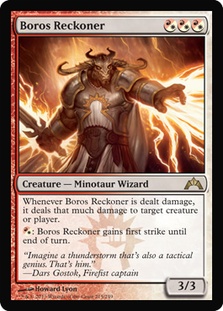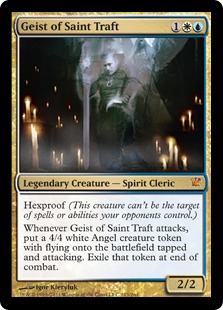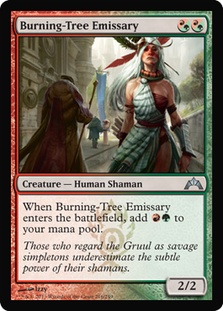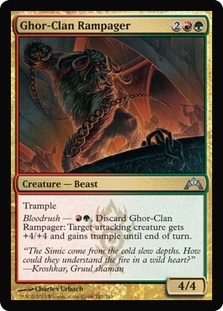If I’ve learned anything in the past few weeks of playing (and watching) Standard, it is that Boros Reckoner is not fun to play against if you’re an aggro deck. That is to say, he is the actual nut against any deck that relies on Searing Spear as its removal spell of choice and will regularly trade two-for-one against virtually every deck in the format that doesn’t have Supreme Verdict in its 75. While Boros Reckoner isn’t exactly fair, I will take having Boros Reckoner be the best creature in the format over Thragtusk any day. The sheer fact that I’m even commenting on this means that we’ve already made a lot of progress.
Since the release of Gatecrash, we’ve had a few Standard events that showed us that aggressive decks are back with a vengeance. Boros Reckoner has singlehandedly started to warp the format, but not in the way you might expect. With such a powerful creature coming down on turn 3 in a variety of decks (thanks to the amazing mana fixing we have with all ten shocklands in the format), midrange and control decks alike are digging for answers that won’t leave them getting blown out.
The importance of having removal in your deck is at an all-time high, but what removal you choose matters more than anything else. Cards like Abrupt Decay and Dreadbore should be seeing more play in Jund right now, leaving cards like Mizzium Mortars and Bonfire of the Damned behind to rot. After Pro Tour Gatecrash in Montreal, we will have a better understanding of how the cards and decks should interact, as the game’s best minds will converge to play Standard. Until then, we can only speculate.
After playing with a bunch of different decks, from Saito’s R/G Aggro and Naya Aggro all the way to Bant Control, there are a whole lot of strategies that click. There are some kinks to work out, as the aggressive decks are all incredibly powerful but still occasionally have trouble beating a Thragtusk. Midrange decks that play too much removal won’t be able to keep up with Sphinx’s Revelation. Control decks that play too few threats will have trouble actually winning the match. While control decks are definitely good, building your control deck correctly is paramount. With every shift of the metagame, changing your deck by a few cards could mean the difference between going 0-2 drop and winning the tournament.
How many copies of Devour Flesh should I play?
Which sweeper effect is best for my color combination?
Who shot John F. Kennedy?
These are all questions you should be asking yourself every night before you go to bed if you want to have a shot at winning the tournament. But enough about history. Let’s talk about the future. Where do we go from here as a control deck?
Blasphemy!
The decklist I’ve been playing, for reference:
Creatures (11)
Lands (25)
Spells (24)

As I said before, Boros Reckoner is likely one of the best options if you plan on beating up on all the aggressive decks. He’s an outstanding two-for-one or better if your opponent doesn’t have an easy answer to him, and you get to do some sweet combo-kill action with Blasphemous Act if you are feeling frisky. Of course, Blasphemous Act is almost always worse than Supreme Verdict, except when it isn’t. I don’t expect this combination to catch on too quickly, but it does feel pretty good to burn your opponent out for more than half their life total.
Hidetsugu’s Second amirite?
But this interaction isn’t just a gimmick. Blasphemous Act can easily act as a sweeper against an aggressive deck trying to flood the board with Flinthoof Boar and Burning-Tree Emissary. It can be a little expensive at times, but that’s why you have access to ways to interact with your opponent in the early parts of the game. Pillar of Flame, Searing Spear, and Azorius Charm are all pretty sweet spells you can play alongside Snapcaster Mage and friends, and Sphinx’s Revelation ties everything together quite nicely.
While there is merit to playing Boros Charm as a way to combo off with Boros Reckoner and Azorius Charm (along with a block in combat), I don’t know if it is worth it. Boros Charm can function as a combo piece or help burn your opponent out alongside Searing Spear and Pillar of Flame. The rest of your creatures help turn you into a tempo deck should the situation call for it, but I have a tough time believing that you’ll be able to kill a Bant opponent in this fashion. They have far too many ways to gain life and play defense.
I do think that U/W/R Tempo/Flash/Control/Midrange/whateveruwannacallit is fairly powerful. It is one of the better shells for The Little Minotaur That Could (Tahngarth would be so proud). I think that hyperaggressive decks were once the soft spot for this deck, but having Boros Reckoner as an early defensive measure alleviates this weakness to an extent. You could always just not draw it and get run over, but you do have access to a ton of removal.
Versatility and Transitioning
While you do have a ton of removal in the maindeck, a lot of those cards have the ability to function as something else. Versatility is key when choosing your spells in a deck like this. Azorius Charm and Izzet Charm have other modes other than "deal with creatures." Similarly, Searing Spear and Pillar of Flame can go to the dome or double up to kill a planeswalker should the need arise. The burn spells are fairly weak against most other control decks, but sometimes you simply want to turn into an aggro deck and smash their face in.
Geist of Saint Traft. Oh, how I’ve missed you. Honestly, what were they thinking when they made this card?
"Hexproof is a fine mechanic when they put it on green idiots like Troll Ascetic. Their mistake was putting it on blue creatures." – Gerry Thompson
Geist of Saint Traft isn’t quite what we want for the maindeck, but it is exactly what we want when we decide to transition to an aggressive deck against some of the more controlling decks in the format. My favorite part about the sideboard is that it feels almost transformational, but not just in a singular way. With cards like Psychic Spiral and Jace, Memory Adept in your sideboard, you have the ability to attack the control decks on two different wavelengths. On one hand, they’ll be spending most of their time and resources trying to stop your Geist of Saint Traft, Boros Reckoner, and Restoration Angel from killing them. Once they tap out for Supreme Verdict, that’s the perfect time for a Jace, Memory Adept to take it home.
While I’m not positive this is the best approach, I do think that you have too many mediocre cards in your maindeck to have a fighting chance against control if you keep them in. Having Geist of Saint Traft alongside Jace gives you resilient threats that are difficult for the control decks to interact with. Along with a slew of counterspells, you should be able to tempo them out of the game or dominate them by milling out their whole deck while they flail about with Thragtusk.
Jund in Every Format
At the moment, I feel like there is a lot of room for innovation in Standard. Having access to so many ways to perfectly fix your mana is awesome, but there’s just something inside of me screaming for a way to punish people for being too greedy. There is very little in the format to keep you from doing basically whatever you want other than the occasional two or four damage from your shocklands. In the past, we had access to cards like Molten Rain, Blood Moon, Magus of the Moon, and Anathemancer to hammer people who got a little out of line. Unfortunately, these cards aren’t fun, which is why one hasn’t seen print in quite some time. Honestly, I’m shocked they even made Skullcrack. People love gaining life.
What having access to all this perfect mana actually did was to make every flavor of aggro deck patently absurd. I’m excited to see the decks that come out in the next few weeks because I need something new to battle with! Recently, everyone’s favorite color combination made back-to-back Top 8s in SCG Atlanta and Edison in the form of an aggro deck featuring…
Experiment One didn’t look all that exciting to me when I first saw it; it definitely took me a while to grasp how good evolve can be. There will be times where you draw multiples of the same creature with evolve and not much else, leading to a bit of awkwardness, but the cheaper creatures with this ability can get out of hand in a hurry! Saito has been experimenting with Gyre Sage, but I’m much more excited to play Experiment One alongside Burning-Tree Emissary and Flinthoof Boar!
The two decks that made the Top 8 of the Standard Opens were identical, but I think there is room for improvement. For one, I’m not a fan of Deathrite Shaman in a deck that has literally no way to use the mana ability. This is especially true when you don’t actually have that many instants and sorceries in your deck to use the black ability. This is even more true when all you want to do every turn is attack until your opponent is dead, meaning you will rarely use any of the abilities on Deathrite Shaman.
I don’t think Deathrite Shaman is a bad card. In fact, it currently defines both Modern and Legacy and very easily could be banned at some point in the near future. I don’t think we’ve reached that point yet, but the existence of fetchlands in those formats leads to some interesting situations. After all, a Birds of Paradise / Grim Lavamancer hybrid that can gain life is fairly powerful, and we haven’t even begun discussing the implications of having a one-mana accelerator in a color that isn’t green. I’m still waiting to see some sweet Deathrite Shaman action in a Geist of Saint Traft Esper deck. Of course, those decks will still play an Overgrown Tomb or Breeding Pool so that they can gain life…
I think that Burning-Tree Emissary is a reasonable switch for Deathrite Shaman in the deck since it allows for some absolutely busted draws in the early parts of the game. I mean, at the very worst he’s just a Grizzly Bear. At its best, you end your second turn with an attack for three and 10+ power in play. That feels a bit like an Affinity nut draw, right?
The only other card that I’d like to see incorporated into the deck is Rancor. It feels like it would fit perfectly, turning all of your threats into powerhouses and keeping you from overextending into Supreme Verdict. Rancor also gives you some reach against decks that can block forever and helps fight through Thragtusk over time. It is possible that Ghor-Clan Rampager is just your Rancor substitute, but I think that you want and can afford both.
Here is a list I’ve been working on, though it probably still needs a little work:
Creatures (28)
- 4 Strangleroot Geist
- 4 Hellrider
- 4 Flinthoof Boar
- 4 Dreg Mangler
- 4 Burning-Tree Emissary
- 4 Experiment One
- 4 Ghor-Clan Rampager
Lands (24)
Spells (8)
Sideboard

This list isn’t perfect, but I think that it has a lot of potential. Rancor might be worse than Thundermaw Hellkite, but it does lead to a lot more games where you nut draw the opponent and run them over. The lack of Abrupt Decay in the maindeck could lead to some awkward interactions with Boros Reckoner, but you can’t afford to have dead cards against control decks. You want all aggression all the time, and you can’t ever afford to slow down.
While the mana base is a bit different thanks to cutting a reasonable number of our black cards, I think it is important to note that Blood Crypt is not the best land in the deck. It doesn’t help us cast all that much in the early game, but it does turn on Flinthoof Boar. This is why we aren’t playing any copies of Dragonskull Summit, as it is just a much worse Blood Crypt. Having access to more basic Mountains gives us more chances to nut draw them with Flinthoof Boar as well as cast Hellrider without problems. With the changes, the only remaining black card in the maindeck is Dreg Mangler, but it most assuredly deserves the slot. The card is simply a powerhouse and is one of the reasons why the deck is so fast.
Searing Spear is the removal of choice, but as you can see, there isn’t all that much of it. Searing Spear has great synergy with Burning-Tree Emissary, and I think it is a much better card at the moment than Pillar of Flame. As I play more with the deck, I wouldn’t be surprised if I end up playing more Abrupt Decay in the maindeck, but at the moment I just want to make the deck runs as efficiently as possible.
This weekend is Pro Tour Gatecrash in Montreal, and while I won’t be attending, I will be rooting for all of my friends. I’ll probably be going to Cincinnati for the StarCityGames.com Open Series since the current Standard format is incredibly fun. I think that Gatecrash has helped to mend some of the problems that I saw in the format over the last few months. Giving a huge boost to aggressive decks has invigorated the metagame, and that means that the control players are going to have to work a lot harder for Sphinx’s Revelation to win the game on the spot.
F*** ’em. We got Skullcrack.
Thanks for reading.
strong sad on Magic Online
@strong_sad on Twitter







